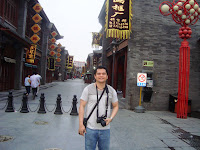The Ancient Culture Street of Tianjin
 The Tianjin Ancient Culture Street dates back 600 years ago. It stands in the key section in upstream Haihe River, which is located in Nankai district of Tianjin. Covering an area of 224,200 sq meters, it used to be one of earliest water transport docklands in Tianjin, one of the busiest cities of commerce and trade in ancient China. As a cultural precinct, Tianjin Ancient Culture Street is well known by the local and overseas tourists alike.
The Tianjin Ancient Culture Street dates back 600 years ago. It stands in the key section in upstream Haihe River, which is located in Nankai district of Tianjin. Covering an area of 224,200 sq meters, it used to be one of earliest water transport docklands in Tianjin, one of the busiest cities of commerce and trade in ancient China. As a cultural precinct, Tianjin Ancient Culture Street is well known by the local and overseas tourists alike.
As the result of the Tian Hou Temple expansions, and renovations of the Yu Huang Ge and Haihe Lou building, this street, with its fine landscape and distinctive architectural style, has been a flourishing cultural and tourist area.
Standing at the center of Tianjin Ancient Cultural Street, Tianhou Palace, originally buil t in 1326, is one of only three Mazu (Goddess of the Sea) Temples in the world (the other two are Fujian Mazu Temple and Beigang Chaotian Temple on Taiwan Island). Tianhou Palace is now the Folk-custom Museum of Tianjin and displays many folk crafts and cultural relics of ancient times.
t in 1326, is one of only three Mazu (Goddess of the Sea) Temples in the world (the other two are Fujian Mazu Temple and Beigang Chaotian Temple on Taiwan Island). Tianhou Palace is now the Folk-custom Museum of Tianjin and displays many folk crafts and cultural relics of ancient times.
 t in 1326, is one of only three Mazu (Goddess of the Sea) Temples in the world (the other two are Fujian Mazu Temple and Beigang Chaotian Temple on Taiwan Island). Tianhou Palace is now the Folk-custom Museum of Tianjin and displays many folk crafts and cultural relics of ancient times.
t in 1326, is one of only three Mazu (Goddess of the Sea) Temples in the world (the other two are Fujian Mazu Temple and Beigang Chaotian Temple on Taiwan Island). Tianhou Palace is now the Folk-custom Museum of Tianjin and displays many folk crafts and cultural relics of ancient times. Yuhuang Cabinet is the only building that was built during the Ming Dynasty (1368-1644) in Tianjin, and is the oldest structure in the street. From the top of the two-floor Cabinet, visitors have a bird's-eye view of the whole street. Another building, Tong Qingli (ancient residential houses), built in 1913 and lying to the east of the cultural street, is the largest architectural edifice that combines both eastern and western architectural elements.
Looking closely, visitors will note that buildings along the street are all built with 'blue bricks', and that the doors and windows have colorful paintings drawn upon them.
These paintings range from stories of legendary and historical figures to flowers and birds. Some retell stories contained in Chinese classical novels, such as The Dream of a Red Mansion (one the four Chinese classical novels) and Song of Eternal Sorrow, which is a story about the Empress Yang Kwei Fei in the Tang Dynasty (618-907).
Visitors who are interested in Chinese traditional handicrafts will also appreciate another Tianjin Ancient Cultur al Street attraction - the hundreds of stores selling a wide variety of folk handicrafts. These include the famous Yang Liuqing New Year Paintings and Niren Zhang Painted Sculptures. Visitors who are fond of Chinese curios, such as jade items, cloisonné and potteries, will also be able to find many examples of these for sale here.
al Street attraction - the hundreds of stores selling a wide variety of folk handicrafts. These include the famous Yang Liuqing New Year Paintings and Niren Zhang Painted Sculptures. Visitors who are fond of Chinese curios, such as jade items, cloisonné and potteries, will also be able to find many examples of these for sale here.
 al Street attraction - the hundreds of stores selling a wide variety of folk handicrafts. These include the famous Yang Liuqing New Year Paintings and Niren Zhang Painted Sculptures. Visitors who are fond of Chinese curios, such as jade items, cloisonné and potteries, will also be able to find many examples of these for sale here.
al Street attraction - the hundreds of stores selling a wide variety of folk handicrafts. These include the famous Yang Liuqing New Year Paintings and Niren Zhang Painted Sculptures. Visitors who are fond of Chinese curios, such as jade items, cloisonné and potteries, will also be able to find many examples of these for sale here. The street is also a favorite place to sample the delicious Tianjin local snacks. The local delicacies include Goubuli Steamed Dumplings, Erduoyan (the Ear-hole Lane) Fried Glutinous Cakes and tea soup.
Tianjin Ancient Cultural Street is designed as a place for tourists to experience C hinese folk custom, and as such, contains examples of nearly all the Tianjin local culture in one place. For an added experience, when visiting the street on March 23rd (lunar calendar), visitors will be lucky enough to find the Huanghui Fair, which is held annually on this date. During the Fair you will see performances of stilt walking, dragon lantern, land boat and lion dances.
hinese folk custom, and as such, contains examples of nearly all the Tianjin local culture in one place. For an added experience, when visiting the street on March 23rd (lunar calendar), visitors will be lucky enough to find the Huanghui Fair, which is held annually on this date. During the Fair you will see performances of stilt walking, dragon lantern, land boat and lion dances.
 hinese folk custom, and as such, contains examples of nearly all the Tianjin local culture in one place. For an added experience, when visiting the street on March 23rd (lunar calendar), visitors will be lucky enough to find the Huanghui Fair, which is held annually on this date. During the Fair you will see performances of stilt walking, dragon lantern, land boat and lion dances.
hinese folk custom, and as such, contains examples of nearly all the Tianjin local culture in one place. For an added experience, when visiting the street on March 23rd (lunar calendar), visitors will be lucky enough to find the Huanghui Fair, which is held annually on this date. During the Fair you will see performances of stilt walking, dragon lantern, land boat and lion dances. The set of 4 stamps above features Tianjin sculptures issued in 1996.






